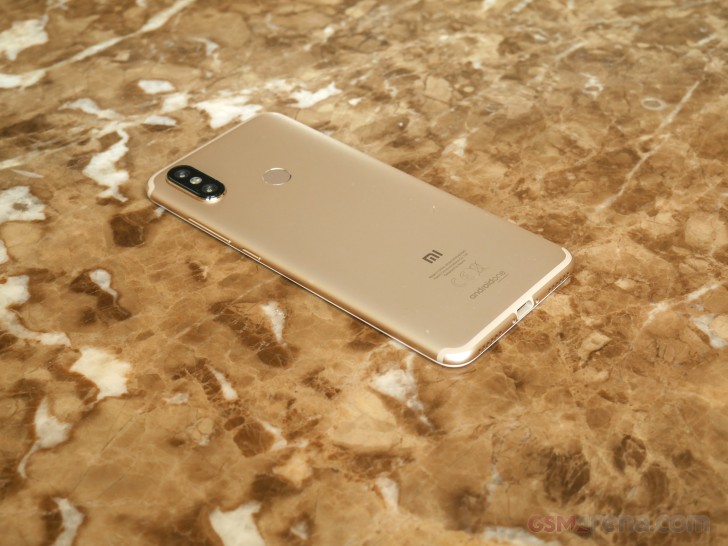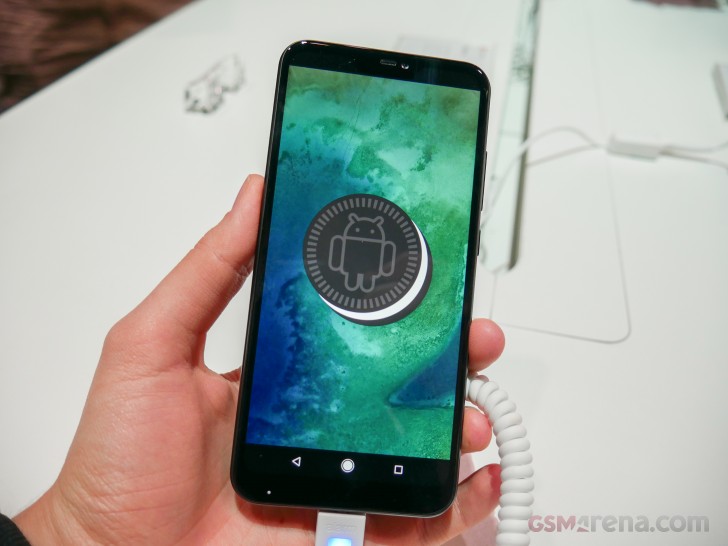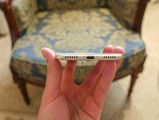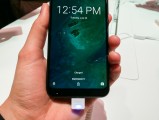Introduction
Last year the Xiaomi Mi A1 was a star in our reviews, the conclusion page in particular. We could recommend the Mi A1 as an alternative to literally every smartphone - from the cheapest droids, to the most expensive top dogs. But its reign is over as the maker is launching not one but two sequels - brace yourselves for the invasion of the Xiaomi Mi A2 and Mi A2 Lite.
Today was the global launch of the Mi A2 series - the wraps were pulled off in Madrid, Spain. The two Mi phones are integral part of the Android One lineup, and Xiaomi gets to sell them worldwide. That's yet another boost to Xiaomi's global expansion.

The Xiaomi Mi A2 is a significant upgrade over the Mi A1 - it has a larger display, more powerful processor and graphics, a better camera setup focused on low-light photography, a 20MP selfie shooter, faster charging, newer Android OS, and promised fast upgrades for at least a year.
Here, check those specs:
Xiaomi Mi A2 specs
- Body: Aluminum body, Gorilla Glass 5 front.
- Display: 5.99" IPS LCD, 1,080x2,160px resolution, 18:9 aspect ratio, 403ppi.
- Rear camera: Primary 12MP, Type 1/2.9" sensor, 1.25µm pixel size, f/1.75 aperture, PDAF; Secondary 20MP for low-light, Type 1/2.8" sensor, 1.0µm pixel size, f/1.75 aperture, autofocus, pixel binning. 2160p/30fps.
- Front camera: 20MP, 1.0µm pixel size, f/1.8 aperture, Auto HDR; 1080p/30fps video recording.
- OS: Android 8.1 Oreo (Android One)
- Chipset: Qualcomm Snapdragon 660: octa-core CPU (4x2.2 GHz Kryo 260 & 4x1.8 GHz Kryo 260), Adreno 512 GPU.
- Memory: 4/6GB of RAM; 32/64/128GB storage; no microSD slot.
- Battery: 3,010mAh Li-Po (sealed); QuickCharge 3.0 fast charging.
- Connectivity: Dual-SIM; LTE, USB-C; Wi-Fi a/b/g/n/ac; GPS; Bluetooth 5.0, IR blaster.
- Misc: Rear-mounted fingerprint reader; single down-firing speaker; no 3.5mm jack (adapter in the box).
Unlike some other brands' Lite models, the Xiaomi Mi A2 Lite isn't just an affordable model stripped down of the premium feats. The Mi A2 Lite, while indeed cheaper, has its own spirit and cool kicks to show off and you can tell it right away.

The Lite has a trendy notched screen with minimum of bezels, mostly aluminum body, still relevant Snapdragon 625 chip, there are microSD slot and audio jack available, a notable 4,000 mAh battery, and there is still a dual-camera setup on the back, though of a different kind. Let's check it out.
Xiaomi Mi A2 Lite specs
- Body: Aluminum body, plastic antenna strips at the back.
- Display: 5.84" IPS LCD with a cutout, 1,080x2,280px resolution, 19:9 aspect ratio, 432ppi.
- Rear camera: Primary 12MP, 1.25µm pixel size, f/1.8 aperture, PDAF; Secondary 5MP, 1.12µm pixel size, f/2.2 aperture - serving as depth sensor; 2160p/30fps.
- Front camera: 5MP, Auto HDR; 1080p/30fps video recording.
- OS: Android 8.1 Oreo (Android One)
- Chipset: Qualcomm Snapdragon 625: octa-core 2.0GHz Cortex-A53 CPU, Adreno 506 GPU.
- Memory: 3/3GB of RAM; 32/64 storage; microSD slot.
- Battery: 4,000mAh Li-Po (sealed);
- Connectivity: Dual-SIM; LTE, microUSB; Wi-Fi a/b/g/n; GPS; Bluetooth 4.2, IR blaster.
- Misc: Rear-mounted fingerprint reader; single down-firing speaker; 3.5mm jack.
Xiaomi gave the notched screen - a feature often considered as premium - to the Lite, while the Mi A2 is getting a larger and perfectly rectangular one. That's a very smart choice - make the Lite feel cooler with that controversial notch, while keep the regular A2 out of that debate.
You bet we have spent some quality time with the Mi A2 phones and our impressions come right after the jump.
Xiaomi Mi A2 hands-on
Design
The Xiaomi Mi A2 is a looker, though little has changed since the A1. The aluminium unibody is as large and as thin as it was on the Mi A1, the fingerprint scanner is thoughtfully positioned at the back, and the dual-camera is around there, too.

The most notable update is the screen, of course, and that's the first thing you'll notice. Xiaomi has adopted the trendy 18:9 aspect ratio for the Mi A2 screen, but don't you worry - nothing has been chopped off here. The display is of 1080p resolution (extended up to 2,160px horizontally) and is a perfect rectangle, well almost - if you look closely you'll see the tiny rounded corners Xiaomi likes to add on its high-end smartphones.

The navigation keys are gone - Xiaomi has kept the Mi A2 footprint the same as Mi A1's so bezels were cut, and the control deck had to go. But that's fine, now you get those keys onscreen and they occupy the extra 240px below the usual 1,920. This way no apps would be broken. You can hide the virtual keys, of course, and opt to use the whole screen estate for specific apps - if you prefer it this way.

Above the screen is the new 20MP selfie camera behind f/2.2 lens. It's actually the same IMX376 sensor as the one Mi A2 uses as a secondary helper on the back for the low-light shots. A warm LED flash is also available at the front.

The selfie department has seen one of the biggest upgrades since the Mi A2 with the new sensor and dedicated flash. The new high-res imager can do real-time auto HDR, but it can also do pixel binning in low-light for some better shots. The high-end selfie experience is boosted with the assistance of so-called AI software which provides portrait shots with blurred backgrounds, smart beautifications, among other enhancements.
Finally, the whole front is protected by a piece of Gorilla Glass 5 - until recently (now there is GG6) the most chatter-proof glass, though it's not as scratch-resistant as older versions.
The rest of the Mi A2 is one piece of aluminium. The frame is thin and with rounded edges, while the back has the antenna lines running around the top and bottom in a way that doesn't interrupt the design. This is pretty much what we saw on the Mi A1, even the fingerprint scanner is at the same spot.

The camera hump looks different though - it now has the vertical alignment of the iPhone X's snappers, also adopted by the recently released Redmi Note 5 Pro. The 12MP main snapper has the top position, the 20MP low-light shooter is at the bottom, while the LED flash is in-between.

The dual-camera has been completely revamped. It has a 12MP sensor for the regular shots, but the 20MP helper is not just for depth-info, it does pixel-binning and will, in theory, produce better low-light photos. Telephoto zoom is not available on the Mi A2 though, as there are is no telephoto lens. Both sensors have bright f/1.75 lenses - another update since the Mi A1 and its f/2.2 and f/2.6.

The camera hump is huge though and the Mi A2 wobbles when put on a flat surface. But there is a transparent case in the retail box, which will get rid of the wobbling if that bothers you.
The Mi A2 packs a 3,000 mAh battery - no improvement in the capacity. There is support for Quick Charge 3.0, but due to the low retail price the phone comes with a regular 10W charger. If you want a faster charging, you'll have to buy a more potent charger.
One thing that had to go for some reason is the 3.5mm audio jack. Why? We can't tell. We doubt Xiaomi could find a proper explanation either. And this will upset a lot of users. But it is what it is. There is a provided USB-C-to-3.5mm adapter in the box if that's any consolation.
Handling the Xiaomi Mi A2 felt much like operating the Mi A1 - same phone, but with a larger display. In spite of the pixels growth, we didn't need to do much finger stretching. The design and the looks are modern, the shape and the matte finish on the metal provide enough grip even though there is a small sense of slipperiness, while the lack of a notch is much appreciated. And if it weren't for the audio jack omission, we would have considered the Mi A2 exterior as pretty flawless.
Software
The Mi A2 runs on the latest available Android Oreo, the vanilla kind, as the phone is part of Android One. This guarantees 2 years of regular updates, but will those be timely enough - it's too early to tell. The same thing was promised for the Mi A1, but the OTAs were often delayed - most notably the update from Android to v8.1. Here is hoping Xiaomi and Google will do it better this time around.
The phone has nothing that could be considered as bloatware, but does come with two Mi apps - Mi Remote and Mi File Manager.
Finally, in addition to the fingerprint security, you can also use Face Unlock - that's Google's Trusted Face option in Smart Lock. It's not secure enough, but it's cool, so it's up to you to decide.
Chipset
Xiaomi Mi A2 runs on one of our favorite mid-range chipsets - the Snapdragon 660. And this is a massive jump over the 625 SoC inside the Mi A1. The 660 silicon has a powerful octa-core processor with Kryo 260 cores and one very capable Adreno 512 that can ooze more than enough fps for a 1080p display.
Until now the Snapdragon 660 chip was powering upper-midrangers and flagship models, so we are beyond happy to see the chip powering a €250 phone.
We ran a few benchmark test to give you a better idea where the Mi A2 stands against its rivals.
GeekBench 4.1 (single-core)
Higher is better
- Nokia 7 plus
1634 - Xiaomi Mi A2
1612 - Oppo R15 Pro
1612 - Samsung Galaxy A8 (2018)
1532 - Oppo Realme 1
1511 - Xiaomi Redmi Note 5 Pro
1327 - Huawei P20 Lite
938 - Nokia 6 (2018)
882 - Motorola Moto G6 Plus
882 - Xiaomi Mi A1
877 - Xiaomi Redmi 5 Plus
874 - Sony Xperia XA2
865 - vivo V7+
767 - Xiaomi Redmi 5
766 - Motorola Moto G6
754 - Samsung Galaxy A6 (2018)
733 - Huawei Y7 Prime (2018)
678
GeekBench 4.1 (multi-core)
Higher is better
- Nokia 7 plus
5893 - Oppo R15 Pro
5809 - Oppo Realme 1
5741 - Xiaomi Redmi Note 5 Pro
4696 - Xiaomi Mi A2
4628 - Samsung Galaxy A8 (2018)
4418 - Xiaomi Redmi 5 Plus
4309 - Xiaomi Mi A1
4292 - Nokia 6 (2018)
4225 - Sony Xperia XA2
4215 - Motorola Moto G6 Plus
4160 - Xiaomi Redmi 5
4018 - Motorola Moto G6
3972 - vivo V7+
3912 - Huawei P20 Lite
3756 - Samsung Galaxy A6 (2018)
3718 - Huawei Y7 Prime (2018)
2717
AnTuTu 7
Higher is better
- Oppo R15 Pro
146526 - Nokia 7 plus
140820 - Oppo Realme 1
138524 - Xiaomi Mi A2
130927 - Xiaomi Redmi Note 5 Pro
107737 - Nokia 6 (2018)
90918 - Motorola Moto G6 Plus
90263 - Huawei P20 Lite
87431 - Motorola Moto G6
70845 - Samsung Galaxy A6 (2018)
63632 - Huawei Y7 Prime (2018)
58974
Camera
Xiaomi has upgraded all three cameras since the Mi A1. The primary setup on the back now has a Sony IMX486 12MP sensor behind f/1.75 lens. It has big enough pixels at 1.25µm and should be capturing some pleasant photos.
The secondary snapper is a 20MP Sony IMX376 with 1.00µm, also behind f/1.75 lens. It is used for depth information for the portrait shots, and does pixel binning in low light. The latter means the camera combines the information from four pixels into one and the result should be a brighter shot.

So, how does it work then? Well - in Auto mode the camera takes all decisions by itself. Its so-called AI decides whether to use pixel binning and which camera should be used to take a photo - it can be with either of them or both. Regardless, you will always end up with a 12MP photo, though if you switch to Manual, you can force a 20MP image out of the Mi A2 too.
The camera app looks barebone and you swipe through the different modes, but there are lots of advanced settings so if creative control is what you need - you can have it.
Naturally, we snapped a few shots with the Mi A2. The photos came out well with nice rendition, pleasant colors and contrast. The dynamic range could have been better and even though we used Auto HDR, the Auto didn't use HDR at scenes where we felt we needed it.




















Xiaomi Mi A2 12MP camera samples
We also took some low-light shots around Madrid. Except for some blurry photos due to the lack of OIS, most of the images look kind of awesome for the class.






Xiaomi Mi A2 12MP low-light photos
The Mi A2 has a second 20MP Sony IMX376 sensor - it serves as a selfie shooter. The cam supports Auto HDR, can do portrait shots with simulated bokeh, and various smart beautifications are available as well.
The selfie shots we took looked great with plenty of detail and an exposure always focused on our faces.




Xiaomi Mi A2 20MP selfies • Selfie • Selfie • Portrait selfie
Xiaomi Mi A2 Lite hands-on
We've seen the Xiaomi Mi A2 before the announcement, as it was first made official in China under a different name - Mi 6X. The same goes for the Mi A2 Lite, which was introduced in China as Redmi 6 Pro. Still, we found the device to bring some surprises at today's event.
The Mi A2 Lite highlight feature is its notched screen with minimal bezels. It's 5.84" in diagonal and with a resolution of 1,080 x 2,280 pixels or 432ppi. That's pretty much the same screen we saw on the Huawei P20 Lite, but we will be able to confirm this once we get a chance to review it.

Anyway, the screen occupies most of the front, looks trendy and cool, with tiny bezels, and the 19:9 aspect is one of the most modern things one could get today. The notch is the other, though the jury is still out on its coolness. But to get this type of screen on a €150 phone, we'd say it's impressive no matter how you look at it.

And the display looks great with high brightness and contrast, lively and punchy colors. Inside the display notch are the earpiece grille, the 5MP selfie camera and a couple of sensors. The front shooter isn't as impressive as on the Mi A2, but it still does HDR and can do 1080p videos. Obviously, the premium selfie experience was reserved for the more expensive phone - the Mi A2.
There are no buttons at the front - the Android will offer you virtual ones. You can hide those in some apps as well and use the entire screen area for yourself.
The back of the Mi A2 Lite is done in the spirit of the older Redmi phones instead of the Mi A1 and A2. It's not a single piece of metal with embedded antennas, but instead, the aluminum ends on plastic strips around the top and bottom. Those hide all the Mi A2 Lite antennas, and in the meantime don't add complexity to the design and its production.

Then, also at the back, is another vertical dual-camera setup, and nearby is also the fingerprint scanner. The camera on the back is similar to what we saw on the most recent Redmi Note 5 models - a 12MP sensor behind f/2.2 lens with phase-detection autofocus, and a 5MP secondary cam for depth information for the portrait shots. There is no 4K video recording, but the 1080p has gyro-based EIS, which is nice.

And here is some good news - the Mi A2 Lite has both a microSD slot and a 3.5mm audio jack. Both of those were missing on the Mi A2 and we are happy to get them in the Lite model.
The phone feels great in hand and looks as modern as the Mi A2, some might consider it even fresher. We don't mind the metal and plastic combo at the back and we think most of the users will like both the looks and the grip.

The Mi A2 Lite runs on the still popular Snapdragon 625 chip, which has an octa-core Cortex-A53 processor and Adreno 506 GPU. It might be an aging SoC, but it has aged so well that Qualcomm has pretty much rebranded it as Snapdragon 450 with some minor changes. It's still working very well underneath a 1080p screen and we are sure it will be up for the job for the next two years. And this chip coupled with the 4,000 mAh battery should do for some remarkable battery life.
Finally, the Mi A2 Lite also benefits from Android One, which means the most recent Android 8.1 Oreo is available and it's free of bloatware. Once again, we hope this time Xiaomi and Google deliver on the promised timely updates for the next 24 months to come.




















0 Response to "Xiaomi Mi A2 and Mi A2 Lite hands-on review"
Post a Comment